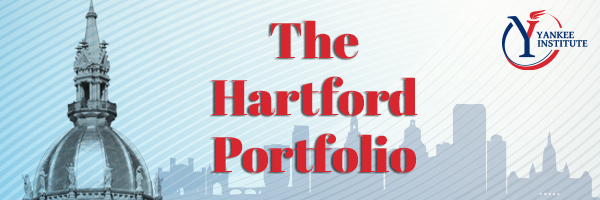For the eleventh consecutive year, Connecticut has ranked among the worst states in America for tax competitiveness — a streak that’s starting to look less like bad luck and more like the inevitable consequences of mistaking high taxes for good governance.
According to the Tax Foundation’s 2026 State Tax Competitiveness Index, the Constitution State places 47 out of 50, performing worse than every New England state and edging out only California, New Jersey, and New York.
The report, which evaluates how efficiently states design and administer their tax codes, found that Connecticut continues to burden residents and businesses with high rates and a tax structure designed for complexity, not growth.
The Numbers Don’t Lie
The Tax Foundation ranks Connecticut:
- 30th for corporate taxes
- 46th for individual income taxes
- 49th for property taxes
- 39th for unemployment insurance taxes
The Tax Foundation notes that when Connecticut eliminates the capital stock tax (to be phased out in 2026), the state could finally see improvement in next year’s Index. Still, one outdated levy disappearing won’t fix the underlying problem. Connecticut keeps making small adjustments at the edges instead of modernizing the broader system that holds its competitiveness back.
What Competitive States Are Doing Right
While Connecticut — the so-called “land of steady habits” — remains stuck near the bottom, other states are moving ahead. Wyoming and South Dakota top the Index by refusing to tax personal income at all. And New Hampshire, Connecticut’s closest peer, eliminated its Interest and Dividends Tax in 2025 and now ranks third overall.
Competitive states share several traits that the Tax Foundation highlights: Simple, neutral tax structures that avoid special carveouts and minimize economic distortion.
- Broad tax bases, which allow rates to stay lower and reduce pressure to raise taxes elsewhere.
- Low, nonpunitive rates that don’t discourage investment or job creation.
- Stable, rule-based systems that avoid unpredictable changes and keep compliance costs manageable.
- Limited taxation of business inputs, preventing tax pyramiding and hidden cost layers that hurt economic growth.
The report makes one thing painfully clear: states that keep their tax codes simple, broad, and predictable consistently outperform those that rely on complexity, exemptions, and “temporary” fixes that never disappear. The states that succeed modernize their systems. The states that fall behind cling to the old one.
The New England Reality Check
When you stack Connecticut against the rest of New England, the picture doesn’t get any prettier.
New Hampshire is in a different tier, ranking third nationally with no income tax and a 7.7 percent corporate rate — yet still beating Connecticut even with high property taxes. Maine lands at 26th, hardly a tax paradise, but miles ahead of Connecticut’s ranking.
Vermont ranks 42nd, weighed down by an 8.75 percent income-tax rate and the worst property taxes competitiveness in America. Massachusetts isn’t far behind at 43rd, thanks in part to its shiny new 4 percent wealth surtax. Rhode Island, at 40th, somehow manages to be more competitive than Connecticut despite its own 6 percent income-tax rate.
And then there’s Connecticut, bringing up the rear at 47th, with a 6.99 percent income-tax rate, a 7.5 percent corporate tax, and the second-worst property taxes in the nation. Put simply, when it comes to bad tax policy, other New England states struggle too — but Connecticut still finds a way to finish last.
Guardrails Matter More Than Ever
Tax competitiveness isn’t just about rates and brackets. The Index consistently rewards states with simple, predictable tax systems — the kind that avoid sudden tax increases, budget gimmicks, and one-off tax fixes. Stability is part of competitiveness.
This is where Connecticut’s fiscal guardrails come in. The spending cap, volatility cap, bond cap, and automatic savings and debt paydown triggers come in. These rules forced the state to adopt a level of discipline it had not shown in decades, restoring the Rainy Day Fund and preventing the unpredictable fiscal swings that led to last-minute budget tricks. The Tax Foundation methodology makes one point unmistakable: a state cannot be competitive without stability. Loosen the guardrails, and Connecticut falls straight back into the unpredictable budgeting the Index penalizes — the kind of instability that keeps states at the bottom. Guardrails don’t guarantee competitiveness but loosening them guarantees instability.
Special Session Decisions Demand Discipline
Connecticut lawmakers have called a Nov. 12–13 special session to revisit the vetoed housing bill, consider an expansion of the Trust Act, expand the public healthcare system, and respond to the fallout from federal cuts and the ongoing federal shutdown.
At the center of the session is Gov. Ned Lamont’s proposal for a $500 million contingency fund to offset disruptions in SNAP, Medicaid, LIHEAP, and other safety-net programs. While the need for a protective measure is clear, a fund this large requires clear, nonpartisan oversight.
To ensure this necessary tool does not evolve into an unrestricted special fund used to bypass Connecticut’s fiscal guardrails, lawmakers must include two key provisions:
- A firm Sunset Date: A clear end date that dissolves the fund when federal support stabilizes.
- Required Return: A mandate that any unused dollars automatically return to the Rainy Day Fund.
Meanwhile, requests for new spending, such as $10 million in higher education loan assistance, reflect a troubling trend of treating special sessions as a chance to reopen the budget, not to address true emergencies. Competitive states aren’t built on improvisation. Connecticut needs discipline, not a budget rewrite driven by last-minute additions that bypass the regular legislative vetting process — the very instability the Tax Foundation says drags states down the rankings.











